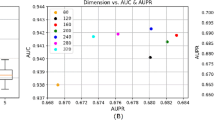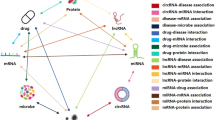Abstract
An increasing number of studies show that identification of lncRNA-miRNA interactions (LMIs) helps the researchers to understand lncRNAs functions and the mechanism of involved complicated diseases. However, biological techniques for detecting lncRNA-miRNAs interactions are costly and time-consuming. Recently, many computational methods have been developed to predict LMIs, but only a few can perform the prediction from a network-based point of view. In this article, we propose a novel computational method to predict potential interactions between lncRNA and miRNA via an embedding learning graph factorize over a heterogeneous information network. Specifically, a large-scale heterogeneous information network is built by combing the associations among proteins, drugs, miRNAs, diseases, and lncRNAs. Then, a graph embedding model Graph Factorization is employed to learn vector representations for all miRNA and lncRNA in the heterogeneous network. Finally, the integrated features are fed to a classifier to predict new lncRNA-miRNA interactions. In the experiment, the proposed method performed good prediction results with AUC of 0.9660 under five-fold cross-validation. The experimental results demonstrate our method as an outperform way to predict potential associations between lncRNAs and miRNAs.
Access this chapter
Tax calculation will be finalised at checkout
Purchases are for personal use only
Similar content being viewed by others
References
Guttman, M., et al.: Chromatin signature reveals over a thousand highly conserved large non-coding RNAs in mammals. Nature 458, 223–227 (2009)
Mattick, J.S.: The genetic signatures of noncoding RNAs. PLoS Genet. 5, e1000459 (2009)
Lander, E.S., et al.: Initial Sequencing and Analysis of the Human Genome (2001)
Kapranov, P., et al.: RNA maps reveal new RNA classes and a possible function for pervasive transcription. Science 316, 1484–1488 (2007)
Chen, G., et al.: LncRNADisease: a database for long-non-coding RNA-associated diseases. Nucl. Acids Res. 41, D983–D986 (2012)
Li, Y., et al.: HMDD v2. 0: a database for experimentally supported human microRNA and disease associations. Nucl. Acids Res. 42, D1070–D1074 (2014)
Szklarczyk, D., et al.: The STRING database in 2017: quality-controlled protein–protein association networks, made broadly accessible. Nucl. Acids Res. gkw937 (2016)
Chen, X., Yan, C.C., Zhang, X., You, Z.-H.: Long non-coding RNAs and complex diseases: from experimental results to computational models. Brief. Bioinf. 18, 558–576 (2017)
Chen, Z.-H., Li, L.-P., He, Z., Zhou, J.-R., Li, Y., Wong, L.: An improved deep forest model for predicting self-interacting proteins from protein sequence using wavelet transformation. Front. Genet. 10, 90 (2019)
Chen, Z.-H., You, Z.-H., Li, L.-P., Wang, Y.-B., Qiu, Y., Hu, P.-W.: Identification of self-interacting proteins by integrating random projection classifier and finite impulse response filter. BMC Genom. 20, 1–10 (2019)
Chen, Z.-H., You, Z.-H., Li, L.-P., Wang, Y.-B., Wong, L., Yi, H.-C.: Prediction of self-interacting proteins from protein sequence information based on random projection model and fast Fourier transform. Int. J. Mol. Sci. 20, 930 (2019)
Huang, Y.-A., Chan, K.C., You, Z.-H.: Constructing prediction models from expression profiles for large scale lncRNA–miRNA interaction profiling. Bioinformatics 34, 812–819 (2018)
You, Z.-H., et al.: PBMDA: A novel and effective path-based computational model for miRNA-disease association prediction. PLoS Comput. Biol. 13, e1005455 (2017)
You, Z.-H., Zhou, M., Luo, X., Li, S.: Highly efficient framework for predicting interactions between proteins. IEEE Trans. Cybern. 47, 731–743 (2016)
Zheng, K., You, Z.-H., Li, J.-Q., Wang, L., Guo, Z.-H., Huang, Y.-A.: iCDA-CGR: Identification of circRNA-disease associations based on Chaos Game Representation. PLoS Comput. Biol. 16, e1007872 (2020)
Zheng, K., You, Z.-H., Wang, L., Zhou, Y., Li, L.-P., Li, Z.-W.: DBMDA: a unified embedding for sequence-based miRNA similarity measure with applications to predict and validate miRNA-disease associations. Mol. Therap. Nucl. Acids 19, 602–611 (2020)
Li, S., You, Z.-H., Guo, H., Luo, X., Zhao, Z.-Q.: Inverse-free extreme learning machine with optimal information updating. IEEE Trans. Cybern. 46, 1229–1241 (2015)
Ye, S., Yang, L., Zhao, X., Song, W., Wang, W., Zheng, S.: Bioinformatics method to predict two regulation mechanism: TF–miRNA–mRNA and lncRNA–miRNA–mRNA in pancreatic cancer. Cell Biochem. Biophys. 70, 1849–1858 (2014)
Jansen, R., et al.: A Bayesian networks approach for predicting protein-protein interactions from genomic data. Science 302, 449–453 (2003)
You, Z.-H., Lei, Y.-K., Zhu, L., Xia, J., Wang, B.: Prediction of protein-protein interactions from amino acid sequences with ensemble extreme learning machines and principal component analysis. BMC Bioinf. 14, S10 (2013). https://doi.org/10.1186/1471-2105-14-S8-S10
Yi, H.-C., You, Z.-H., Huang, D.-S., Li, X., Jiang, T.-H., Li, L.-P.: A deep learning framework for robust and accurate prediction of ncRNA-protein interactions using evolutionary information. Mol. Therap. Nucl. Acids 11, 337–344 (2018)
Suresh, V., Liu, L., Adjeroh, D., Zhou, X.: RPI-Pred: predicting ncRNA-protein interaction using sequence and structural information. Nucl. Acids Res. 43, 1370–1379 (2015)
Wang, L., You, Z.-H., Chen, X., Yan, X., Liu, G., Zhang, W.: RFDT: a rotation forest-based predictor for predicting drug-target interactions using drug structure and protein sequence information. Curr. Protein Peptide Sci. 19, 445–454 (2018)
Shi, H., et al.: Walking the interactome to identify human miRNA-disease associations through the functional link between miRNA targets and disease genes. BMC Syst. Biol. 7, 101 (2013)
Peng, J., et al.: A learning-based framework for miRNA-disease association identification using neural networks. Bioinformatics 35, 4364–4371 (2019)
Griffiths-Jones, S., Saini, H.K., Van Dongen, S., Enright, A.J.: miRBase: tools for microRNA genomics. Nucl. Acids Res. 36, D154–D158 (2007)
Fang, S., et al.: NONCODEV5: a comprehensive annotation database for long non-coding RNAs. Nucl. Acids Res. 46, D308–D314 (2018)
Wishart, D.S., et al.: DrugBank: a knowledgebase for drugs, drug actions and drug targets. Nucl. Acids Res. 36, D901–D906 (2008)
Lipscomb, C.E.: Medical subject headings (MeSH). Bull. Med. Libr. Assoc. 88, 265 (2000)
Miao, Y.-R., Liu, W., Zhang, Q., Guo, A.-Y.: lncRNASNP2: an updated database of functional SNPs and mutations in human and mouse lncRNAs. Nucl. Acids Res. 46, D276–D280 (2018)
Huang, Z., et al.: HMDD v3. 0: a database for experimentally supported human microRNA–disease associations. Nucl. Acids Res. 47, D1013–D1017 (2019)
Chou, C.-H., et al.: miRTarBase update 2018: a resource for experimentally validated microRNA-target interactions. Nucl. Acids Res. 46, D296–D302 (2018)
Cheng, L., et al.: LncRNA2Target v2. 0: a comprehensive database for target genes of lncRNAs in human and mouse. Nucl. Acids Res. 47, D140–D144 (2019)
Piñero, J., et al.: DisGeNET: a comprehensive platform integrating information on human disease-associated genes and variants. Nucl. Acids Res. gkw943 (2016)
Wishart, D.S., et al.: DrugBank 5.0: a major update to the DrugBank database for 2018. Nucl. Acids Res. 46, D1074–D1082 (2018)
Davis, A.P., et al.: The comparative toxicogenomics database: update 2017. Nucl. Acids Res. 45, D972–D978 (2017)
Breiman, L.: Random forests. Mach. Learn. 45, 5–32 (2001)
Funding
This work is supported by the Xinjiang Natural Science Foundation under Grant 2017D01A78.
Author information
Authors and Affiliations
Contributions
The authors declare that they have no conflict of interest.
Corresponding author
Editor information
Editors and Affiliations
Rights and permissions
Copyright information
© 2020 Springer Nature Switzerland AG
About this paper
Cite this paper
Zhou, JR., You, ZH., Cheng, L., Zhou, X., Li, HY. (2020). Prediction of lncRNA-miRNA Interactions via an Embedding Learning Graph Factorize Over Heterogeneous Information Network. In: Huang, DS., Jo, KH. (eds) Intelligent Computing Theories and Application. ICIC 2020. Lecture Notes in Computer Science(), vol 12464. Springer, Cham. https://doi.org/10.1007/978-3-030-60802-6_24
Download citation
DOI: https://doi.org/10.1007/978-3-030-60802-6_24
Published:
Publisher Name: Springer, Cham
Print ISBN: 978-3-030-60801-9
Online ISBN: 978-3-030-60802-6
eBook Packages: Computer ScienceComputer Science (R0)




